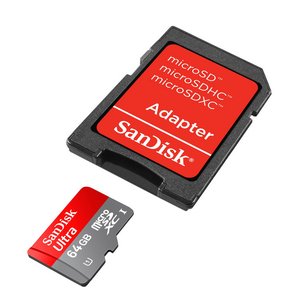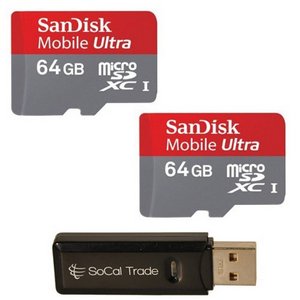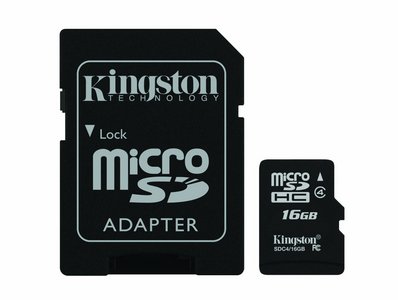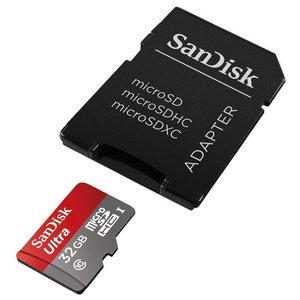Today I’m revisiting another popular topic that regularly attracts new site visitors: SD vs. microSD cards. I won’t bore you with all the technical details of what makes a microSD card different from a standard SD card, because I’m pretty sure all you care about is whether or not a microSD card will work with your various devices.
The answer is, so long as your device can accept a standard SD card, yes, it can accept a micro SD card — provided you have a standard SD card adapter or USB plug-in adapter (as pictured in this post).
You can buy micro-to-standard SD card adapters and USB plug-in adapters on their own, but plenty of micro SD cards come bundled with adapters, too.

To use a microSD card in a device that takes standard SD cards (most digital cameras, for example), you just slide the micro SD card into the adapter’s card slot, then insert the adapter into your device the same as you would any standard SD card. Notice how the adapter looks almost identical to a standard SD card.
To use a microSD card with a computer, you have some options. If your computer has a standard SD card slot, use the adapter method I just described. If not, you can use a USB plug-in adapter (pictured below).
The bundle shown below includes two microSD XC cards with a capacity of 64GB each, together with a USB plug-in adapter. You slide the microSD card into a slot on the end of the USB plug-in adapter, then plug the adapter into your computer or other device that has an available USB port. (Note that the microSD cards are magnified in this photo. In reality they’re pretty tiny and will definitely fit into the slot on the end of that USB adapter.)

Why Micro SD?
MicroSD cards were invented to provide extra memory on very small devices, like cell phones. In terms of functionality, from the user’s perspective they work just the same as standard SD memory cards. They’re just smaller.
For a long time the conventional wisdom about the two card types was that the standard-size SD card is typically less expensive and faster than its microSD counterparts, but over on Tested Wesley Fenlon reports that SanDisk’s “Extreme” line of microSD cards has largely closed that gap.
Since micro SD cards are more versatile, in that you can use them in a wider variety of devices than standard SD cards, a micro SD card + adapter combo is generally the smarter buy, especially if you can find the micro SD + adapter bundle with the amount of memory you want at a lower price than the comparable standard SD card.
What Does It Mean When The Card Is Labeled “SDHC” or “SDXC”?
HC and XC are designations that indicate the card uses advanced technology to speed up its file access and processing times, and provide additional memory capacity. HC cards can handle up to a 32MB capacity, XC cards can handle up to a 2 terabyte capacity. A terabyte is 1,000 gigabytes, so that’s a LOT of memory to squeeze into such an itty-bitty memory card.
When HC, and later, XC cards first came onto the consumer electronics market, only certain devices could handle the faster file processing so you had to carefully check to ensure your device could actually accept an HC/XC card before buying one. Now, HC is pretty much standard technology for any recent-model device that accepts SD or micro SD cards up to 32 GB, and XC is the typical designation you’ll find on a card with higher capacity than 32GB.

XC cards can also handle MUCH more capacity than HC cards: up to 2 terabytes in the standard SD card size. As of this writing, the largest capacity micro SD XC card you’ll find is 64GB.
Buy The Right Capacity Card For Your Devices
Micro SD cards are commonly available in capacities anywhere from 1 gigabyte to 128 gigabytes and their prices are very much in line with standard SD cards, but different devices have different limitations on the amount of memory they can handle in an SD card or microSD card so you shouldn’t just assume the largest capacity microSD card will be the best value for you.
Most current-model cell phones, MP3 players and other devices that accept micro SD cards can handle a 64GB card, but there are some that will only use up to a 32GB card and some older devices can only handle a 16GB card. Check your user’s manual, or if the manual’s long gone try checking your thingie’s technical details on Amazon or at the manufacturer’s website.
If You Buy The Wrong Capacity Card…
When you insert an SD or microSD card with higher memory capacity than your device can use, one of two things will happen. The first possibility is that your device will work just fine with the larger capacity card, but will only be able to use as much of the memory on the card as your device’s specifications say it can handle. The second possibility is that your device won’t be able to read the higher capacity card at all, and will show you an error when you try to use it.
Since you can’t know ahead of time which of these will happen with your specific device, it’s best to err on the side of caution and only use cards that meet the maximum capacity limit(s) of your device(s).
* * *
And now…
The SanDisk Ultra 32GB UHI-I/Class 10 Micro SDHC Memory Card w/ Adapter comes from a trusted name in computer memory hardware, has an average review rating of 4.5/5 stars on Amazon, is currently the #1 bestselling memory card in Amazon’s cell phones and accessories category, and is now (as of 4/14/16) on sale for just $15.49 with Prime Shipping eligibility.

* * *
Ebook Tech Tip of the Week: How To Tell If A YA Novel Is More A Than Y Before You Buy
* * *